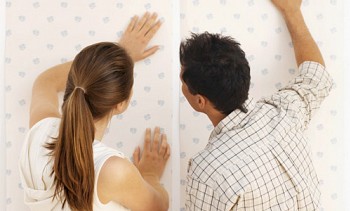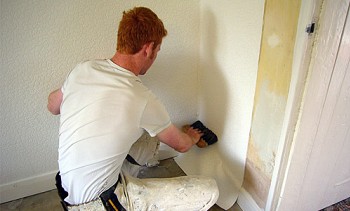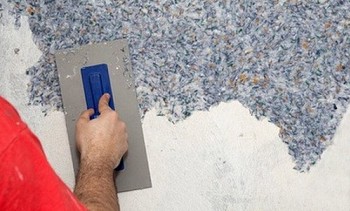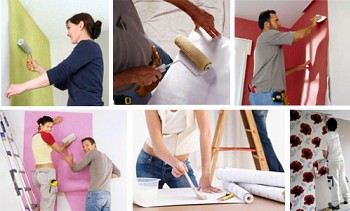Non-woven wallpaper is a wonderful finishing material that will appeal to the most demanding customer. The thickened structure of non-woven wallpaper perfectly conceals minor wall defects. Therefore, thorough preliminary preparation and creation of a perfectly smooth wall surface are not required. How to glue non-woven wallpaper so that it lasts a long time and delights in its quality, you will learn from the step-by-step instructions that are given in this article.
 Photo - mitre10.co.nz
Photo - mitre10.co.nz
Content:
The non-woven wall covering does not need special care. Wet cleansing completely updates the wallpaper. Contaminated areas are perfectly removed with special cleaning products. The undoubted and important advantage of non-woven wallpaper is an amazing visual effect.
Non-woven wallpaper after the sticker is resistant to deformation, shrinkage and stretching. Acrylic and dispersion dyes are excellently applied to feselin wallpapers. They are not at all afraid of moisture, so they are easy to clean. If necessary, it will not be difficult during the repair to remove the old wallpaper, and then stick new ones. Thanks to the relief, you can create the illusion of a beautiful relief stucco.
Preparation for pasting with non-woven wallpaper
Necessary tools
- laser level;
- 5m roulette;
- special roller with a long pile;
- plastic spatula: which should have a soft edge for a perfect wallpaper roll;
- brush: serves to smooth the glued wallpaper;
- sharp knife for cutting wallpaper;
- special mesh to remove excess glue from the roller;
- narrow metal spatula;
- two buckets: for glue and clean water;
- foam sponge;
- pencil.
Wall preparation and marking
First you need to inspect and prepare the surface of the walls for gluing. An excellent surface for decal on non-woven wallpaper can be: paper, wood, drywall, particleboard, plaster, concrete and other similar materials.
Tip: the color of the surface of the walls for the sticker on the wallpaper for painting should be uniform. It is desirable that the color of the surface is not very different from the color of the painted wallpaper.
Please note: non-woven is thin, so the color of the base may be noticeable.
The preparation of the walls for gluing begins with cleaning the surface of old wallpaper, dirt and eliminating defects. It is advisable to remove old paint. As a last resort, carefully process the painted surface with sandpaper (medium caliber). Be sure to treat the prepared surface with a primer.
Non-woven wallpaper have smooth high-quality edges. This allows you to apply the method of stickers "butt". At the same time, visually adjacent panels look almost seamless, like a single canvas. Because non-woven wallpaper most often produces a wider format, then we will consider how to glue wide non-woven wallpaper. It is better to start work from the corner of the room. From the corner of the room at a distance of 1 meter, strictly vertically, using a level, draw an approximate line.
The purpose of the markup: when deciding the wallpaper, strictly adhere to the vertical lines. Using a level, strictly vertical lines are applied across the wall in 1 meter increments. The standard width of non-woven wallpaper is 1.06 m. Therefore, as a rule, a certain margin is created during the sticker. Then it is convenient to use it when making a clear junction in the corners of the room.

Drawing a strictly vertical reference line.
Photo - kvotvet.ru
Wallpaper Preparation
So, the surface layout for the wallpaper is ready. The next step is to prepare the wallpaper for the sticker.We recommend cutting blanks of wallpaper immediately on all walls of the room. The complexity of the cut depends on the wallpaper pattern.
If docking of the picture is not required, cutting is not difficult. The only remark: before cutting the next blank of wallpaper, measure the height of the wall at different points (for example, after 30 cm). And just making sure that the height of the walls is the same everywhere, cut the blank of the wallpaper of the required size.
If you glue wallpaper with a large pattern, then the wallpaper will require the selection of a pattern. You can find out what size fit for your wallpaper, just by looking at the icon on the label. When marking, make sure that the pattern matches. To do this, you periodically have to shift the subsequent workpiece up or down. The main thing is to avoid mistakes and not to allow you to glue pieces of wallpaper from the bottom or top.
On some sites you can find advice to leave a margin of 10-15 cm in height when cutting wallpaper with a pattern. Please note: if you have high ceilings, this does not always save the situation.
For example: the fit size is 48 cm, and the height of the room is 2.5 meters. In this case, according to the rules of cutting, the length of each workpiece must be a multiple of 48, but be sure to exceed the height of the room. For our case: the required length of the workpiece 2, 88 m.
After mathematical calculations, we proceed to slicing. We lay on the floor a clean plastic wrap or wash the floor well. Face down we roll a roll of wallpaper. We measure 2 m 88 cm (with a margin for adjustment) and make a notch with a knife. Then, by serif, we bend the wallpaper so that the edges of the bent part and the main lower panel coincide. After checking everything, cut the sheet of wallpaper along the fold line.
We grow the next sheet of wallpaper by turning it on the same side as the previous one. Then we check the fit of the drawings of the two obtained paintings: the lower one lying on the floor, and the upper one cut off, bending their edges. For control, we find and visually highlight a noticeable detail of the picture. We try to combine both blanks according to this figure. If everything is done correctly, we proceed to the preparation of the next workpiece.
Attention: the roll must be rolled out sequentially, on the one hand. Thus, they cut the blanks immediately to the entire room.

Special table for marking wallpaper. Photo - mega-anunt.ro
Cooking glue
What glue to glue the flesilin wallpaper with? To sticker non-woven wallpaper, you must choose a quality adhesive designed specifically for non-woven wallpaper. The technology of its preparation is simple. To do this, in the necessary according to the instructions, a small amount of water is gradually sprinkled with a thin stream of glue powder, stirring the mixture vigorously. Allow the mixture to infuse for a while, and then mix it again and remove the lumps, if any. The glue mixture is ready.
Step by step wallpaper sticker
Now let's talk directly about how to glue wallpaper on a non-woven basis.
Step 1. To avoid confusion, first read the factory instructions that came with the wallpaper. There may be specific comments on sticker technology. Some, few manufacturers recommend smearing not only the wall but also the wallpaper itself.
Attention: we recommend for better adhesion of the edges of the wallpaper to the wall, a little more area is spread over the width of the wallpaper.
Try to apply the adhesive mass evenly. When pasting with feselin wallpaper, as a rule, the adhesive mixture is applied with a roller only to the wall surface. Undoubtedly this is a more comfortable and easy way to sticker wallpapers. Use glue intended for non-woven wallpaper and do not try to use glue that remains from the last repair.
Step 2 The result of all the work depends on the quality of the sticker of the first blank. It is the first sheet that will be the starting point for comparing the verticality for subsequent workpieces. Therefore, especially carefully strictly vertically arrange the first sheet of the workpiece from top to bottom. To fasten the wallpaper sheet to the wall, smooth it with a spatula.Squeeze out excess glue to the side where there are no pasted wallpapers.
Note: if wallpaper with a deep texture is used, then for smoothing use a wallpaper roller, while pressing it strongly should not be.
Step 3 Cut off the rest of the wallpaper below. The baseboard can only cover 3-4 cm, so do not cut too much. Then we look for any extra wallpaper on the ceiling. We carefully trim, leaving a small margin for subsequent closure with a ceiling plinth. We cut off the excess strips of wallpaper, pressing the spatula with the wallpaper into a corner. In this case, the knife does not come off the cut line, but only the spatula moves. This technology to remove excess wallpaper allows you to keep the cut line straight.

Clipping wallpaper, top left, bottom right bottom floor.
Photo - axsoris.com
Step 4 We remove the traces of excess glue on the ceiling by washing the surface with a damp sponge or rag. Do not be afraid to soak the non-woven wallpaper. Wipe the corner seam thoroughly to remove all traces of glue. Manufacturers of adhesive bases sometimes assure that the adhesive will not leave any marks after drying. But still, places with glue will shine ugly.
Step 5 Glue the next sheet back to the previous glued blank. Wallpaper does not shrink after the glue dries, so no gaps will occur. Roll the prepared panel of wallpaper strictly vertically along the wall, combining the intended details of the picture and at the same time moving it to the previous workpiece. Iron the joints with a roller. Excess glue is removed to the side free from wallpaper. We cut off excess wallpaper from the bottom and top.
Step 6 Similarly, we glue and trim the wallpaper in the corners. The difference - gently press down both panels on the two sides of the corner with a spatula and trim at the same time. We take out one of the excess cut strips from under the panel. For reliability of bonding, we additionally coat the corner with glue, if he has managed to dry out and press the wallpaper panel to the corner.
Video: Sticking non-woven wallpaper




